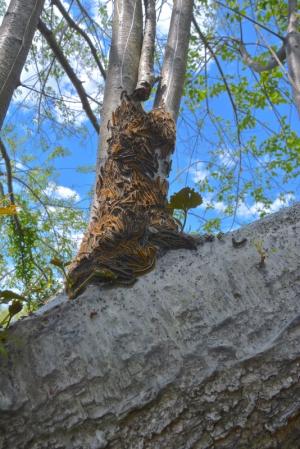Eastern tent caterpillars are back in business
They're small, fuzzy and really nothing more than an eyesore.
Eastern tent caterpillars are a common sight when spring temperatures begin to rise, creating web-like nests in nearby trees. The fuzzy black, white and orange insects, which are one of the earliest active caterpillars in Delaware, favor nesting in and feasting on the leaves of apple and cherry trees throughout the state.
Individually, they're not bad looking bugs, said Brian Kunkel, an integrated pest management specialist at the University of Delaware's Cooperative Extension. When they become active – usually earlier in the year around March, he said – clusters of caterpillars in a tree can be a little gross, he admitted.
But if left unchecked, they can potentially defoliate a tree, which with continual years of defoliation, can compromise the tree's ability to recover or stave off other infestations, he said. Other than that, they're mainly known as eyesores or nuisances, with the exception of an instance in Kentucky more than a decade ago when female horses feeding on grasses dotted with the caterpillars suffered reproductive problems. Kunkel said it was found that the hairs on the caterpillars are poisonous, but that this issue, known as Mare Reproductive Loss Syndrome, has not been an ongoing problem since scientists identified an eastern tent caterpillar infestation as the cause.
Dealing with the bugs does not require high-tech equipment or pesticides, Kunkel said. All that's needed is a stick to break up the nests, which provide a protective barrier for the worms, so that nature can take its course. Birds and other predatory insects will do what they do best: chow down and cut back on the caterpillar population.
This year, the caterpillars are emerging a little later than usual due to lingering cold weather. Now, the worms are leaving their nests in search of suitable places to hunker down and build a cocoon so they can emerge as Eastern tent caterpillar moths later in the summer, usually around the end of July or early August, Kunkel said.
Local horticulturist John Feliciani, co-owner of Black Hog Farmstead in Lewes, said he's seeing the caterpillars a little later than usual, but their numbers seem normal.
“I haven't noticed an explosion this year,” he said, adding that it's just now warm enough for people to be out and about to even notice the bugs. “It's a pain for your good apple trees, but out in the wild it's a part of nature.”
For more information on how to handle Eastern tent caterpillars, check out Kunkel's video at https://www.youtube.com/watch?v=u1QTsfaYav8.






















































